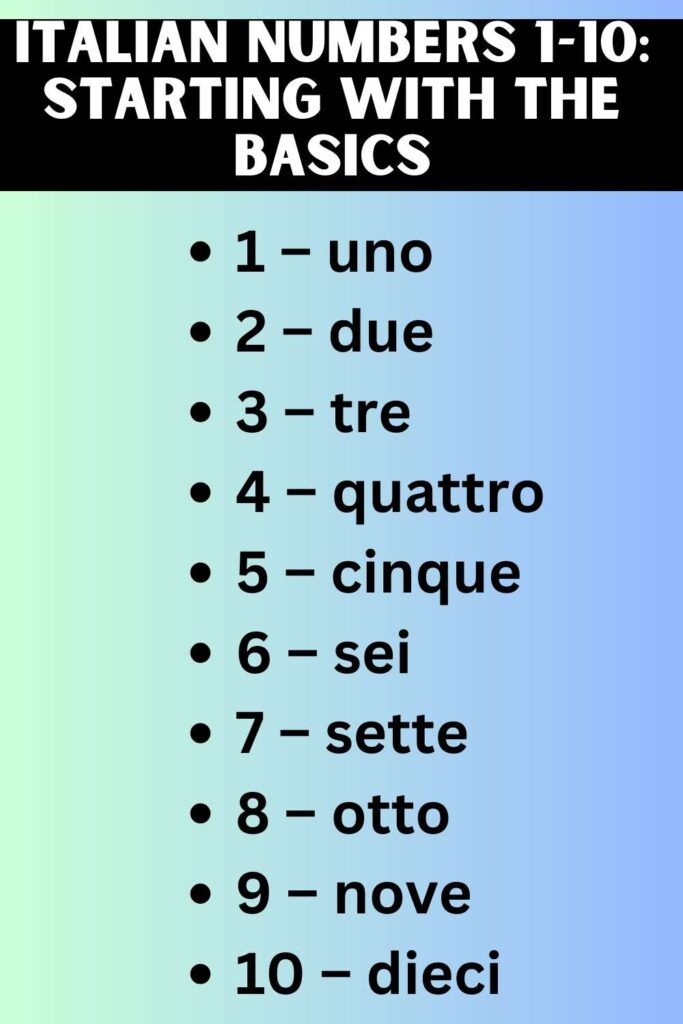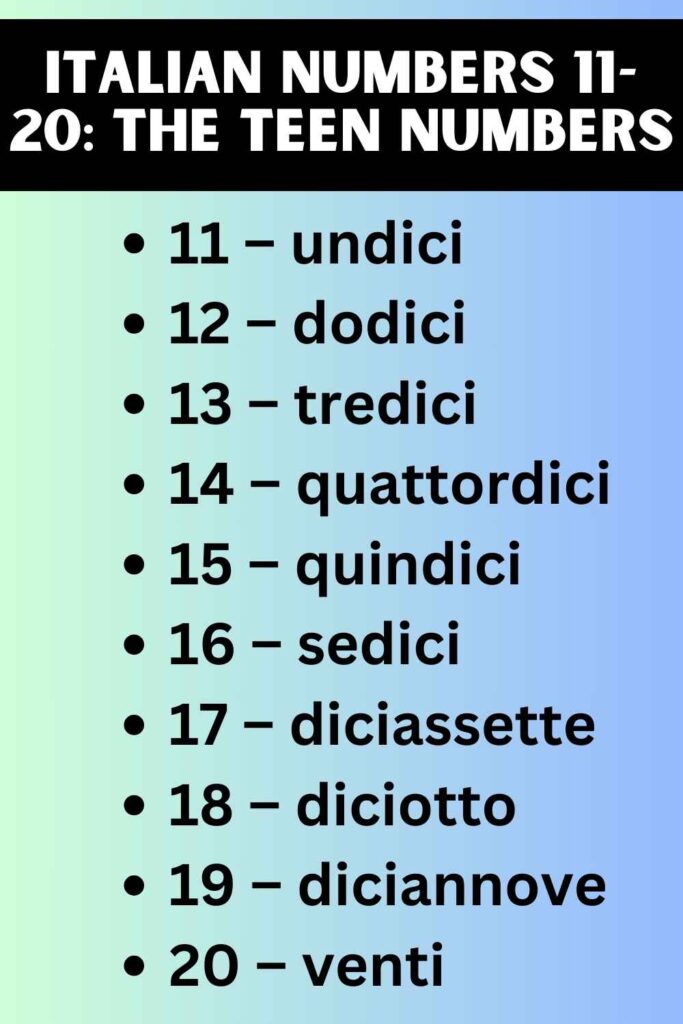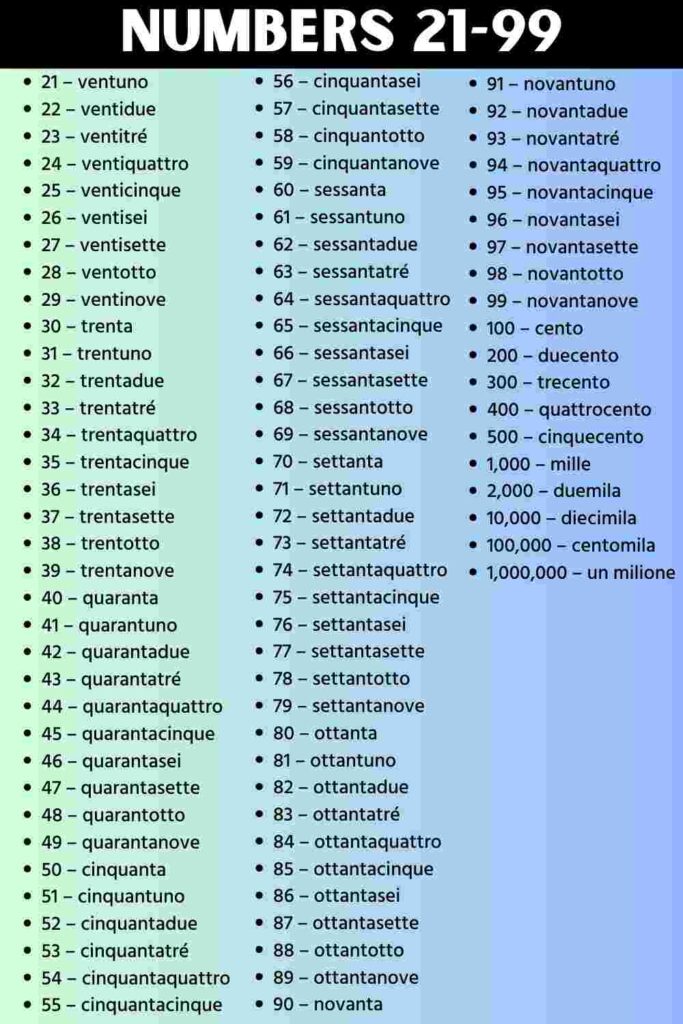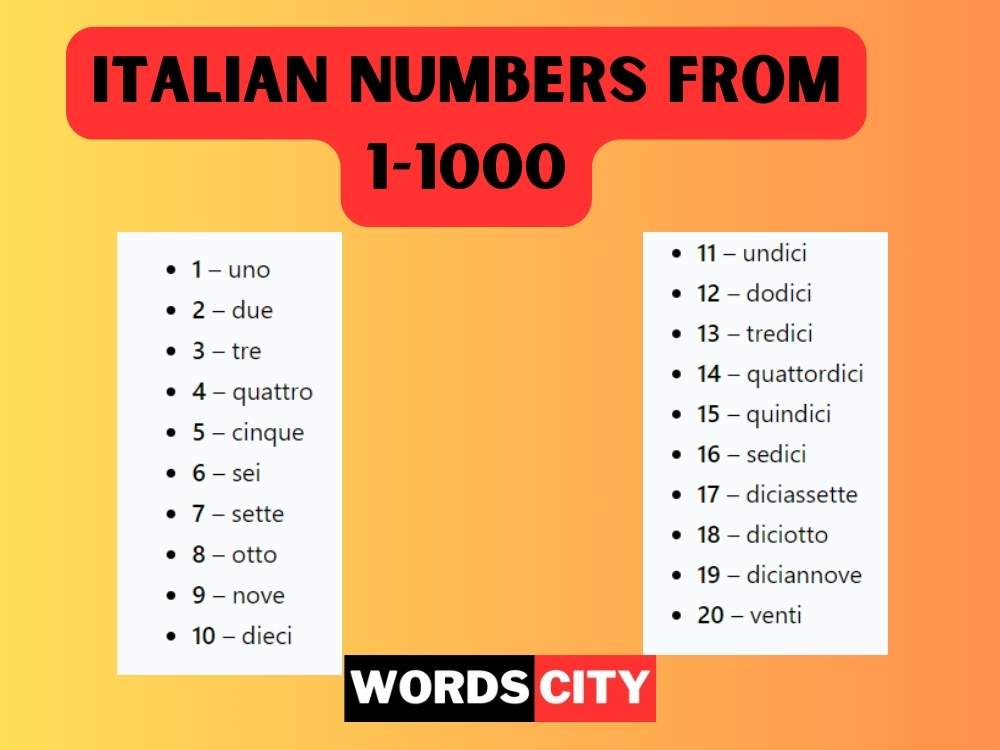Whether you’re planning a trip to Italy, studying Italian, or simply curious about the language, learning how to count in Italian is one of the most practical skills you can develop. Numbers are an essential part of everyday life, from ordering food at a restaurant to asking for directions or managing time. In this in-depth guide, we’ll cover everything you need to know about Italian numbers, from the basics to more complex forms, and even throw in some tips to help you understand how numbers fit into Italian culture.
Table of Contents
Why Learn Italian Numbers?
Numbers are the building blocks of communication in any language. In Italy, numbers play a vital role in daily activities, and knowing how to use them properly will improve your ability to shop, travel, and interact with locals.
- Traveling: Knowing numbers will help you book hotels, pay for transportation, and understand street addresses.
- Shopping: Numbers are essential when talking about prices, quantities, and measurements in shops or markets.
- Socializing: You’ll need numbers for exchanging contact information, understanding dates, and participating in conversations.
Learning Italian numbers is the key to unlocking many practical skills in the language. Let’s start by breaking down Italian numbers from 1 to 1,000 and beyond.
Italian Numbers 1-10: Starting with the Basics
Italian numbers 1 to 10 are crucial because they form the base of almost all the other numbers in the language. Here’s a quick overview:
- 1 – uno
- 2 – due
- 3 – tre
- 4 – quattro
- 5 – cinque
- 6 – sei
- 7 – sette
- 8 – otto
- 9 – nove
- 10 – dieci

Key Points for Beginners:
- Uno changes form when it’s used before a noun. For example, “un libro” (a book), but “uno zaino” (a backpack).
- The number due is used in plural contexts. For example, “due amici” (two friends).
The pronunciation of these numbers is relatively straightforward, but practicing them out loud will help solidify your skills.
Italian Numbers 11-20: The Teen Numbers
Italian numbers from 11 to 20 follow a somewhat irregular pattern compared to English. While most numbers in Italian are compound, these teen numbers are slightly different in structure:
- 11 – undici
- 12 – dodici
- 13 – tredici
- 14 – quattordici
- 15 – quindici
- 16 – sedici
- 17 – diciassette
- 18 – diciotto
- 19 – diciannove
- 20 – venti

Important Notes:
- The numbers 17 through 19 have “dici” at the beginning (from “dieci” meaning ten), but the digits are reversed in construction (e.g., diciotto for eighteen).
- Diciassette (17) is considered an unlucky number in Italian culture, much like the number 13 in some cultures. This is because its Roman numeral form (XVII) can be rearranged to spell VIXI, which means “I have lived” (i.e., I am dead) in Latin.
Read Also: Mastering French Numbers 1-100 : A Comprehensive Guide
Numbers 21-99: Patterns and Rules

- 21 – ventuno
- 22 – ventidue
- 23 – ventitré
- 24 – ventiquattro
- 25 – venticinque
- 26 – ventisei
- 27 – ventisette
- 28 – ventotto
- 29 – ventinove
- 30 – trenta
- 31 – trentuno
- 32 – trentadue
- 33 – trentatré
- 34 – trentaquattro
- 35 – trentacinque
- 36 – trentasei
- 37 – trentasette
- 38 – trentotto
- 39 – trentanove
- 40 – quaranta
- 41 – quarantuno
- 42 – quarantadue
- 43 – quarantatré
- 44 – quarantaquattro
- 45 – quarantacinque
- 46 – quarantasei
- 47 – quarantasette
- 48 – quarantotto
- 49 – quarantanove
- 50 – cinquanta
- 51 – cinquantuno
- 52 – cinquantadue
- 53 – cinquantatré
- 54 – cinquantaquattro
- 55 – cinquantacinque
- 56 – cinquantasei
- 57 – cinquantasette
- 58 – cinquantotto
- 59 – cinquantanove
- 60 – sessanta
- 61 – sessantuno
- 62 – sessantadue
- 63 – sessantatré
- 64 – sessantaquattro
- 65 – sessantacinque
- 66 – sessantasei
- 67 – sessantasette
- 68 – sessantotto
- 69 – sessantanove
- 70 – settanta
- 71 – settantuno
- 72 – settantadue
- 73 – settantatré
- 74 – settantaquattro
- 75 – settantacinque
- 76 – settantasei
- 77 – settantasette
- 78 – settantotto
- 79 – settantanove
- 80 – ottanta
- 81 – ottantuno
- 82 – ottantadue
- 83 – ottantatré
- 84 – ottantaquattro
- 85 – ottantacinque
- 86 – ottantasei
- 87 – ottantasette
- 88 – ottantotto
- 89 – ottantanove
- 90 – novanta
- 91 – novantuno
- 92 – novantadue
- 93 – novantatré
- 94 – novantaquattro
- 95 – novantacinque
- 96 – novantasei
- 97 – novantasette
- 98 – novantotto
- 99 – novantanove
Once you know the numbers up to 20, learning to count higher becomes much easier because Italian numbers follow predictable patterns after that.
Notes:
- Drop the final vowel of the tens when combined with -uno or -otto to make pronunciation smoother (e.g., ventuno not ventiuno, ventotto not ventiotto).
- Numbers like 23 (ventitré) and 33 (trentatré) keep the accent on the final “é” in “tré.”
Counting by Tens:
- 30 – trenta
- 40 – quaranta
- 50 – cinquanta
- 60 – sessanta
- 70 – settanta
- 80 – ottanta
- 90 – novanta
When forming numbers between tens, you simply combine the tens with the unit. However, there’s a special rule when combining 1 or 8 with the tens.
Combining 1 and 8 with Tens:
- 21 – ventuno (not ventiuno)
- 28 – ventotto (not ventiotto)
The final vowel of the tens number is dropped when adding “uno” or “otto,” making pronunciation smoother.
For other numbers, you combine the tens with the unit normally:
- 35 – trentacinque
- 47 – quarantasette
- 59 – cinquantanove
Pronunciation Tips:
- Stress: Pay attention to where the stress falls in each number. In numbers like “ventuno” (21), the stress is on the “u,” while in “trentatré” (33), it’s on the “tré.”
Italian Numbers 100 and Beyond: Larger Numbers
Hundreds:
- 100 – cento
- 200 – duecento
- 300 – trecento
- 400 – quattrocento
- 500 – cinquecento
When counting into the hundreds, simply add the base number in front of “cento.” This pattern holds for all numbers up to 999.
Thousands:
- 1,000 – mille
- 2,000 – duemila
- 10,000 – diecimila
- 100,000 – centomila
- 1,000,000 – un milione
The plural form of “mille” (thousand) is mila, so 2,000 becomes duemila, 3,000 is tremila, and so on. For even larger numbers, like a million, “milione” (million) and “miliardo” (billion) are used.
Cultural Insight:
The number mille is used in a famous Italian idiom, “Grazie mille,” meaning “a thousand thanks.” While it literally translates to “thanks a thousand,” it’s a commonly used phrase for “thank you very much.”
Ordinal Numbers in Italian: First, Second, Third, and Beyond
Ordinal numbers in Italian are used to indicate order or rank, like first, second, third, and so on. These are particularly useful for understanding dates, addressing invitations, or discussing sports scores.
Examples of Ordinal Numbers:
- First – primo
- Second – secondo
- Third – terzo
- Fourth – quarto
- Fifth – quinto
- Sixth – sesto
- Seventh – settimo
- Tenth – decimo
For numbers beyond tenth, ordinal numbers are formed by adding the suffix -esimo to the base number:
- Eleventh – undicesimo
- Twentieth – ventesimo
- Thirtieth – trentesimo
Ordinal numbers are crucial when reading dates in Italian. For example, “il primo luglio” means “the first of July.”
How to Use Italian Numbers in Everyday Situations
Once you’ve mastered the basics of Italian numbers, applying them in real-life situations will help reinforce what you’ve learned.
In Restaurants:
- “Vorrei tre pizze, per favore.” – “I would like three pizzas, please.”
- “Quanto costa?” – “How much does it cost?”
In Shopping:
- “Mi dia due chili di arance, per favore.” – “Give me two kilos of oranges, please.”
Asking for Phone Numbers:
- “Qual è il tuo numero di telefono?” – “What is your phone number?”
Learning these practical phrases will make interacting in Italian environments much easier.
Conclusion: Master Italian Numbers with Practice!
Italian numbers are an essential part of daily communication, and they follow relatively simple patterns once you understand the basics. From uno to milione, these numbers are your gateway to navigating life in Italy with confidence. Practice using numbers in real-world scenarios, and don’t be afraid to make mistakes—every interaction is a learning opportunity.
Ready to test your skills? Start using these Italian numbers in conversations, travel plans, and even phone number exchanges. Buona fortuna—good luck, and happy counting!


Your content is always so engaging and informative. Thanks for this!